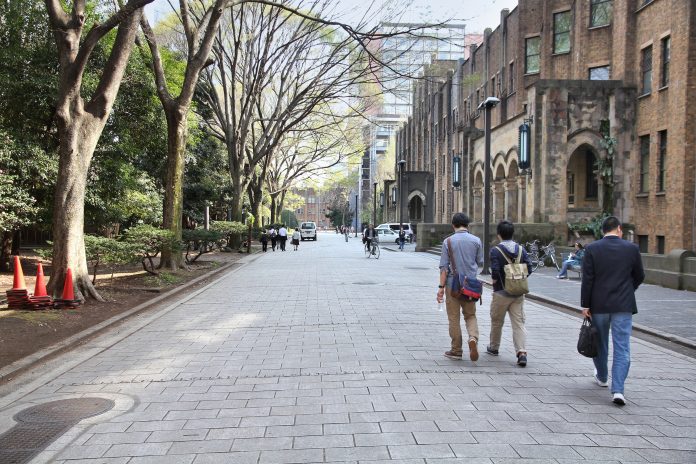Here, we find out about the importance of higher education and language learning in Japan, two areas that fall under the remit of Kōichi Hagiuda, Japan’s Minister Of Education, Culture, Sports, Science and Technology
Kōichi Hagiuda has been the Japanese Minister of Education since September 2019, leading the Department’s Top Global University Project.
Before he became Minister of Education, Kōichi Hagiuda spent one year (2015-2016) as the Deputy Chief Cabinet Secretary, where he was heavily involved in Public Relations and other administrative work. As a member of the Liberal Democratic Party of Japan (LDP), Hagiuda is expected to embody conservative-leaning policies which generally support rapid economic growth, a strong relationship with the U.S. and privatisation of state-owned entities. However, the party itself lacks a clear-cut ideology, enabling individuals to occupy a spectrum of right-leaning beliefs.
MEXT’s official plan for Higher Education in Japan says: “In the age of knowledge-based society and ongoing globalization, higher education institutions have been asked to play increasingly important roles.”
The Japanese Ministry of Education, Culture, Sports, Science and Technology (MEXT) has a leading project to elevate their universities to compete in a globalised economy – known as the Top Global University Project, MEXT lends its support to “those universities that are leading the internationalization of Japan’s education.”
What is the Top Global University Project?
MEXT’s Top Global University Project splits the future of Japanese education in two:
Type A, aka Top Type
These universities are required to conduct “world-leading education and research”, with 13 officially selected by the Japanese Government since 2016. These are the MEXT-chosen intellectual greats, who are poised to land comfortably in the Top 100 Universities of the world. They are armed with an “interdisciplinary joint curricula” which collaborates with foreign universities and must also demonstrate a culture which “attracts high-calibre faculty and students”. This is similar to institutions like the University of Oxford and Hiroshima University, the latter being on the Type A list.
Type B, aka Global Traction Type
37 universities have been chosen from this category by MEXT, which means they have fostered “innovative educational partnerships”, which should contribute to the dream of globalised university education. These universities are expected to internationalise education as well as society – fueling a mutual change. MEXT are working with this group to focus on university reform, looking to nurture many more institutions to join them.
Language learning
Using the MEXT criteria list for universities, Minister Kōichi Hagiuda is expected to encourage a rise in international student population from 36,545 in 2013, to 73,536 in 2023.
What is the MEXT list of criteria for top Japanese universities?
Some of the ways that the Ministry of Education attempts to guide the growth of international collaboration and presence within education include the suggestion of introducing a tenure track system, hiring administrative staff who meet international language proficiency levels and increasing the number of subjects taught in foreign languages. Largely, the Top Global University Japan project focuses on increasing the presence of foreign languages, as the student generation becoming fluent in Mandarin Chinese or (as emphasised by MEXT) English, is expected to boost the Japanese economy.
What about domestic education plans outside of university?
Kōichi Hagiuda has said that MEXT will be looking into creating a new system for the English part of university entrance exams, which is expected to roll out in the year 2024. Previously, the plan was for a new test to be introduced in the fiscal year 2020.
At a press conference on 1st November 2019, Minister Hagiuda commented: “We are not fully confident that students can take the current test system on an equal basis and without worries.”
The proposed tests required a level of training that private-sector organisations have been largely responsible for, with their own preparations to tutor students and assist the overall process. Some of these groups may be able to sue for compensation at the delay in changing over to the new form of test.
Language learning
Using the MEXT criteria list for universities, Minister Kōichi Hagiuda is expected to encourage a rise in international student population from 36,545 in 2013, to 73,536 in 2023.
What is the MEXT list of criteria for top Japanese universities?
Some of the ways that the Ministry of Education attempts to guide the growth of international collaboration and presence within education include the suggestion of introducing a tenure track system, hiring administrative staff who meet international language proficiency levels and increasing the number of subjects taught in foreign languages. Largely, the Top Global University Japan project focuses on increasing the presence of foreign languages, as the student generation becoming fluent in Mandarin Chinese or (as emphasised by MEXT) English, is expected to boost the Japanese economy.
Finally, one more area to look at concerns the importance of introducing classes in English, which is one of the many points covered in the comprehensive document, Higher Education in Japan. This ties in with the wider aim of the internationalisation of universities. Due to today’s environment of globalisation, “it is very important for Japanese universities to conduct lessons in English for a certain extent, or to develop courses where students can obtain academic degrees by taking lessons conducted entirely in English,” we are told.
Staying on the theme of language, it is worth noting here that in early November 2019, 50 high school students from Asia visited MEXT. Minister Koichi met 50 high school students from Asia who studied Japanese culture and language from Japanese teachers dispatched as part of the “NIHONGO Partners” Program. The initiative is managed by the Japan Foundation and essentially sends out Japanese teachers to secondary schools in Asia to assist with teaching classes and introducing Japanese culture there.
One student Myanmar, Yong, portrayed her teacher as like a mother, a big sister and friend, which ensured she could use Japanese confidently without fear of making any errors. An Indonesian student, Firman, said he is grateful to his teacher, Yuri, who was a key figure in motivating him to learn more about Japan’s culture and language.
We can note that Minister Hagiuda, therefore, encouraged the students to carry on studying Japanese and one day hopes to see them serving as a bridge between their country and Japan.
References
1. https://www.mext.go.jp/en/news/topics/detail/1423050.htm
2.https://www.mext.go.jp/en/policy/education/highered/title03/detail03/__icsFiles/afieldfile/2012/06/19/1302653_1.pdf











